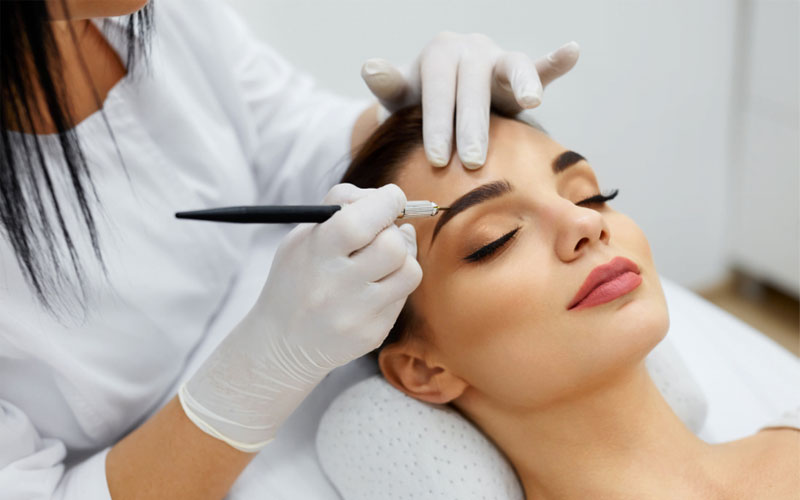
An eyebrow transplant is a relatively quick outpatient procedure done under local anesthesia. Choosing a surgeon who is experienced in this type of surgery is essential.
Use a technique that mimics your brow hair’s natural direction, angle, and curvature. The goal is to create a look that complements your face and eye area.
What Is an Eyebrow Transplant?
What is an eyebrow hair transplant? Eyebrow hair transplant is a cosmetic procedure involving hair follicles to increase eyebrows’ density, shape, and distribution. It can also help cover scars caused by accidents or injuries. Eyebrow hair transplants for men and women with thin, sparse, or nonexistent brows can be done. Dermatologic, cosmetic, or plastic surgeons can perform the procedure. This procedure can be done in a hospital or medical spa as an outpatient.
Using follicular unit transplantation (FUT) or follicular unit excision techniques, hair follicles from the back of your head are taken and implanted in the area around your eyebrows. Small circular scars are left behind in the donor area, but they will become unnoticeable when the surrounding eyebrow hair grows out.
The transplanted follicles will grow and eventually fill in the eyebrow area, giving you fuller, more natural-looking brows. It may take six months or more for the grafts to mature, but once they do, your brows will look completely natural and make you appear younger and healthier.
How Does an Eyebrow Transplant Work?
Eyebrow transplants provide a permanent solution to fuller eyebrows, which can eliminate the need for makeup or other temporary methods of making your brows appear thicker. The procedure involves using your natural hair to fill in your brows, which means the results are more realistic than tattoos or other cosmetic solutions that use synthetic materials.
During the procedure, hair follicles are taken from the nape of the neck or around the ears and transplanted to the brow area. Each graft includes both the hair and its root, which helps ensure new hair will grow once the transferred hairs fall out or enter a resting period.
The procedure typically takes four hours and is done under twilight anesthesia. Once the hair follicles are moved, the eyebrow area must heal for about four days when you cannot get it wet.
The resulting brows may take some time to look natural, but the transplanted hairs should stay permanently in place once they’ve matured. However, they must be touched up if you lose your natural hair.
What Are the Benefits of an Eyebrow Transplant?
Eyebrow transplant restores growing hair to brow areas with thinning or no coat and covers scars from burns or surgery. Eyebrow transplants are also a good option for people with other skin conditions that can affect eyebrow hair growth, such as telogen effluvium (baldness).
This procedure is outpatient, and you will go home the same day. You may experience some scabbing at the surgical site and redness around your face for several days after surgery. You should not pick at these scabs or submerge the area in water. If you have a sensitive look, apply saline spray or ointment to soothe these areas.
It is essential to find a surgeon with extensive experience with this procedure who can provide before and after pictures to show you the results. Shopping around for a provider offering financing and payment plans is also good. It would help if you also chose a board-certified surgeon with similar credentials. It will help ensure that you receive the best possible care.
What Are the Risks of an Eyebrow Transplant?
The risks of an eyebrow transplant are typically very low and can be minimized by selecting a surgeon who specializes in this procedure and has experience with it. Your provider should be willing to provide you with a portfolio of their work to help you decide if they are a good fit for your cosmetic goals.
Eyebrow hair restoration surgery is an outpatient procedure that requires a short recovery period. It is essential to have someone available to drive you home after the process and help care for your needs during this time.
You may experience swelling and bruising in the area where hair follicles were placed. Some scabbing and crusting may also occur, which is normal. It is also important not to get the area wet as this can lead to infection.
Post-surgery, your doctor will provide comprehensive instructions on how to care for yourself. Following them closely can ensure that your results look natural and healthy. You should also avoid using makeup on the area and refrain from waxing or eyebrow threading until after your doctor permits you.
What Are the Recovery Periods for an Eyebrow Transplant?
An eyebrow transplant is an outpatient procedure. General anesthesia is used to ensure you don’t feel any pain during the surgery. However, you may experience some discomfort as the anesthesia wears off afterward.
An experienced surgeon can produce an excellent result with minor bleeding, scarring, and infection risk. But, as with any elective cosmetic procedure, complications can occur. The most common complications include infections and suboptimal graft placement.
Eyebrow hair follicles are transplanted using either the strip/FUG or the FUE technique, depending on the desired look and a patient’s goals and concerns.
The resulting grafts are then carefully placed in the brow area to be improved, ensuring an aesthetic, natural-looking result. This process takes several hours to complete. Some patients require a second surgery to achieve the desired brow shape, but most are satisfied with their results after just one procedure.







